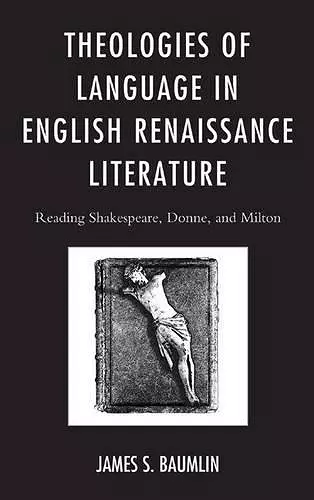Theologies of Language in English Renaissance Literature
Reading Shakespeare, Donne, and Milton
Format:Paperback
Publisher:Lexington Books
Published:14th Oct '14
Currently unavailable, and unfortunately no date known when it will be back
This paperback is available in another edition too:
- Hardback£109.00(9780739169605)

James S. Baumlin’s Theologies of Language in English Renaissance Literature offers a revisionist history of discourse, taking Shakespeare, Donne, and Milton as its touchstones. Their works mark stages in die Entzauberung or “disenchantment,” as Max Weber has termed it: that is, in the “elimination of magic from the world.” Shakespeare’s Hamlet questions the word-magic associated with medieval Catholicism; Donne’s love lyrics ironize the sacramental gestures of their poetic-priestly speakers; more radical still, Milton’s major poems and polemical prose empty language of sacral power, repudiating human persuasion entirely over matters of “saving faith.” Baumlin describes four archetypes of historical rhetoric: sophism, skepticism, incarnationism, and transcendence. Undergirding the age’s competing theologies, each makes unique assumptions regarding the powers of language (both communicative and performative); the nature of being (including transcendent being or deity); the structure of the psyche (whether sin-weakened or self-sufficient); and the capacities of human knowing (whether certain knowledge is communicable—or even possible). Working within divergent theologies of language, the poets here studied take theological controversies as explicit themes. The crisis of Hamlet begins not in a king’s murder simply, but in his dying without benefit of the sacraments. As if compensating for their loss, young Hamlet “minister[s]” to Gertrude while acting as “scourge” to Claudius. Alternating between soul-cursing and soul-curing, Hamlet plays sorcerer and priest indiscriminately. Appropriating the speech-acts of Catholic sacramentalism, Donne’s lyrics describe a private “religion of Love,” over which the poet-lover presides as officiant. Or rather, some lyrics present him as Love’s Priest, there being as many personae as there are theologies of language. Beyond Love’s Priest, Baumlin describes three such personae: Love’s Apostate, Love’s Atheist, and Love’s Reformer. Focusing on “Lycidas” and De Doctrina Christiana, Baumlin outlines Milton’s plerophoristic “rhetoric of certitude.” Such texts as these explore the problematic status of preaching. (Can human eloquence contribute to salvation?) They explore competing definitions (Aristotelian vs. Pauline) of pistis—meaning alternatively (religious) “faith” and (rhetorical) “persuasion.” And they invoke conflicting typologies (classical vs. Hebraic) of authorial ethos. Baumlin’s study ends with a glance at the Restoration and Royal Society’s final “disenchantment” or secularization of discourse.
In a stunning synthesis of literature, rhetoric, theology, and culture, Baumlin uses Shakespeare, Donne, and Milton as waystations on a new path through the English Renaissance. The traveler will find history rendered more complex and more concrete. There is much to learn on this journey. And much to astonish. -- George H. Jensen, author of Identities Across Texts
With a breadth of learning balanced by the sensitivity of his readings, Baumlin lays out the various theologies that inform the language use of Shakespeare, Donne, and Milton. Perhaps most impressive is his ability to place the works in longitudinal conversation with each other and with larger Reformation disputes over rhetoric and theology. From Hamlet to Paradise Regained, Baumlin makes one think hard and new about the secularization and desacralization of language in the late Renaissance. -- Sean Benson, University of Dubuque
Extending a discussion of English rhetoric he began in John Donne and the Rhetorics of Renaissance Discourse (CH, Nov'91, 29-1348), Baumlin (Missouri State Univ.) focuses on the theologically inflected rhetorics of Shakespeare, Donne, and Milton. Following two chapters on Renaissance reading practices and adaptations of classical eloquence to Christian doctrine, he finds Hamlet's language mediating both Catholic and reformed beliefs. Three chapters present Donne's varied poetic personas of priest, apostate, and atheist. Three more chapters probe Milton's "kerygmatic and Spiritualist" rhetoric, which distinguishes it from that of Donne and classical theorists. Lycidas covertly derides the Laudian church, while Milton's "rhetoric of certitude" separates it from ancient models. Baumlin reads numerous poetic and prose texts meticulously; especially where Donne is concerned, he offers polyvalent readings stressing multiple voices and techniques rather than arguing for more restrictive, definitive interpretations….in all this volume helpfully explores the intersection of early modern rhetoric and faith. It deserves a place alongside such recent studies as Brian Cummings's The Literary Culture of the Reformation (2002). Summing Up: Recommended. * CHOICE *
But rhetoric provides the fabric of this book. It demonstrates how a thorough understanding of Renaissance rhetoric and its intimate relation to theology can yield provocative readings of complex literary texts. Its style is clear: Baumlin acknowledges and engages the work of other scholars while carefully distinguishing his own line of argument. His frequent use of italics insures that readers can follow crucial points of theory. This book is a powerful demonstration of the importance of rhetorical theory to our understanding of English Renaissance literature. All scholars writing on the rhetoric of Shakespeare, Donne, or Milton should read it. * Renaissance Quarterly *
Benjamin's study is packed, learned, and provocative—well worth the reading. * Milton Quarterly *
ISBN: 9780739190647
Dimensions: 226mm x 155mm x 23mm
Weight: 463g
316 pages